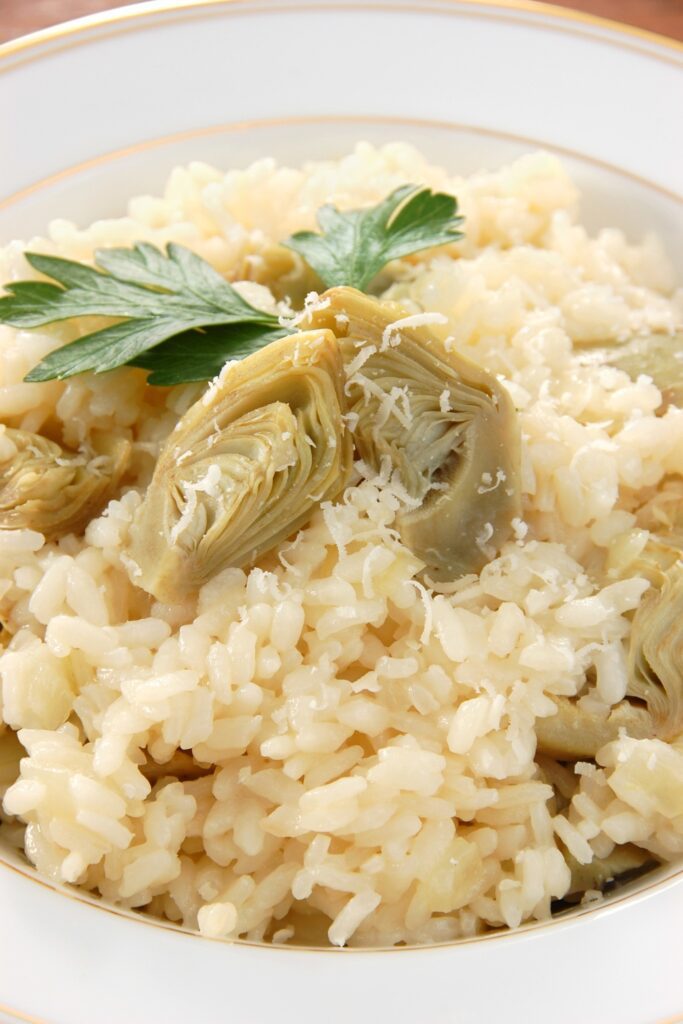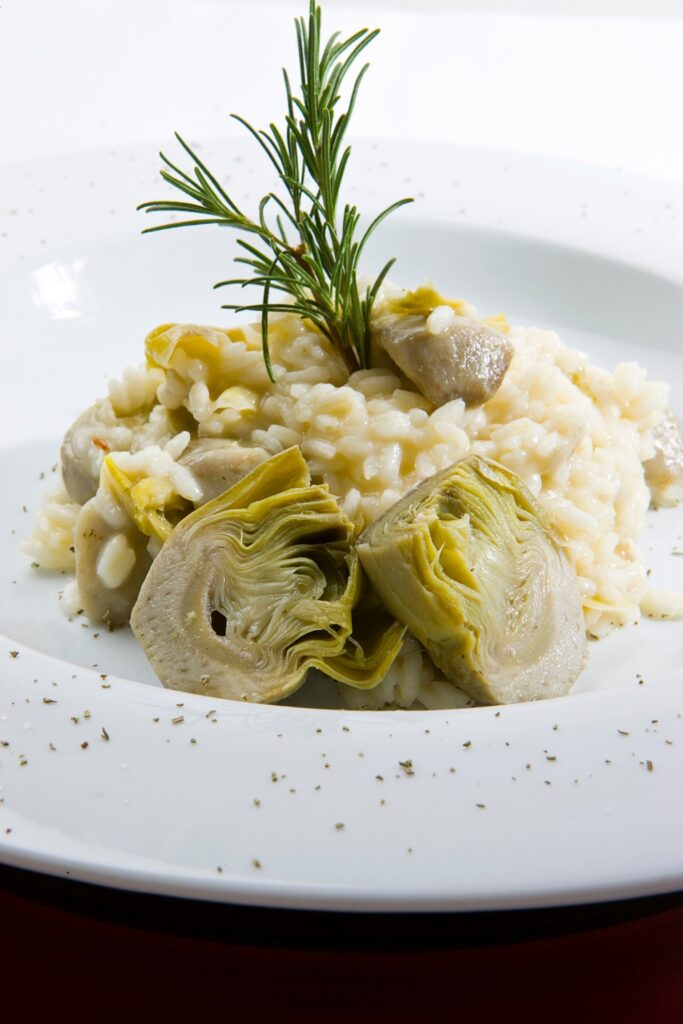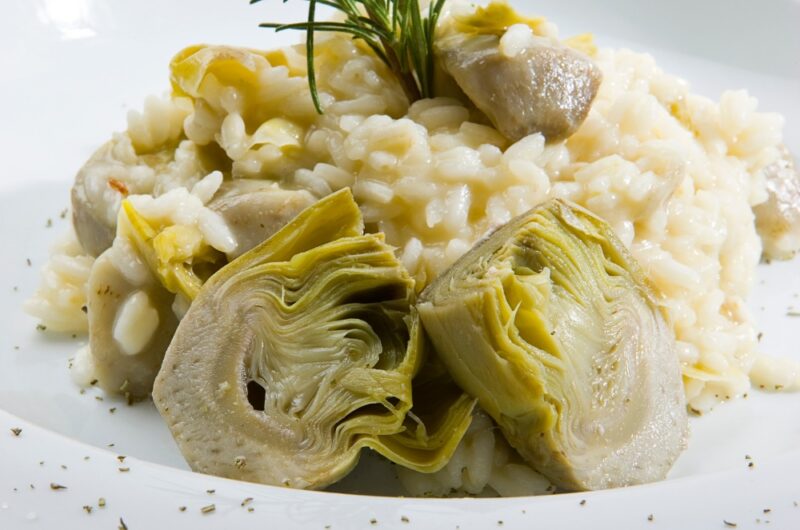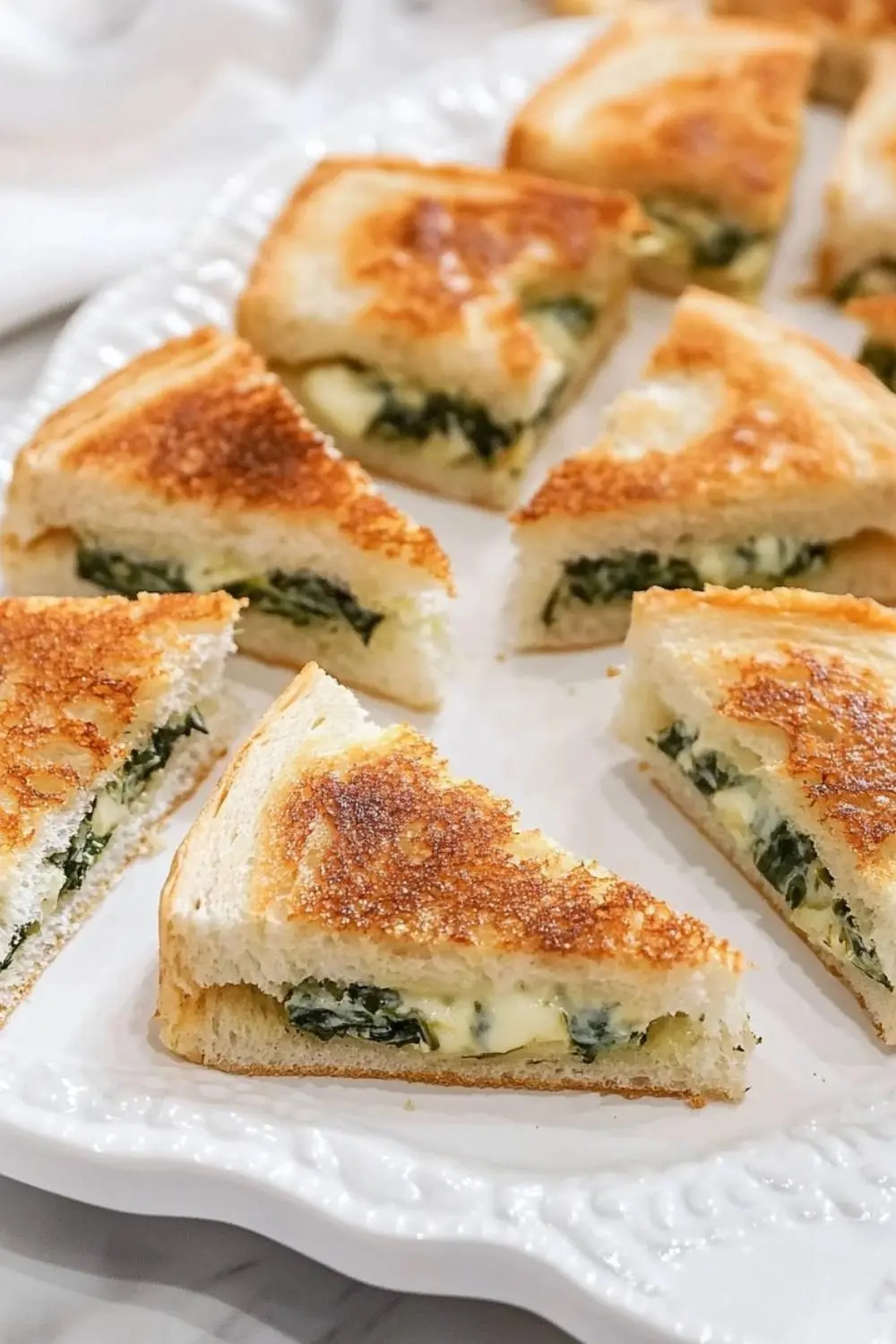I love this delicious Artichoke Risotto by Giada De Laurentiis—it’s packed with flavors and super easy to make using Arborio rice, artichoke hearts, olive oil, white wine, and chicken broth.
To make Giada’s Artichoke Risotto, start by sautéing artichokes in olive oil, then cook the shallots and rice. Slowly add wine and broth, stirring until creamy, about 30 minutes.
Explore more of Giada’s recipes beyond this Risotto; she offers a great variety of classic Italian dishes such as Fettuccine Alfredo, Panzanella, and Amalfi Lemon Chicken that are absolutely delightful.
Can I Use Jarred Artichokes Instead of Frozen?
Absolutely, you can use jarred artichokes, no problem! Just make sure to rinse them well to get rid of the excess brine. This will keep your risotto from tasting like a salt mine.

Giada De Laurentiis Artichoke Risotto Ingredients
- 1/4 cup of extra-virgin olive oil
- 9 ounces of frozen artichoke hearts, chopped into bite-size wedges
- 1 tbsp of unsalted butter
- 1 large shallot, minced (or 2 small ones if you can’t find a large one)
- 1 cup of Arborio rice
- 1 tsp of salt
- 1 cup of dry white wine, at room temperature
- 3 1/2 cups of low-sodium chicken broth, warmed up
- 1/2 cup of thawed frozen peas
- 1/2 cup of crumbled feta cheese (that’s about 3 ounces)
- 1/4 cup of finely chopped chives
- 1/4 cup of chopped fresh mint
- 1/4 tsp of freshly ground black pepper
- 1 tbsp of fresh lemon juice (squeeze it from half a small lemon)
How To Make Giada De Laurentiis Artichoke Risotto
- Heat It Up: Pour 2 tbsp of olive oil into a medium saucepan and crank it up to high heat. Toss in the artichoke wedges. Turn down the heat to medium-high and let them sizzle for about 10 minutes. You’re looking for a nice golden brown color. Once there, scoop them out onto a plate and keep them handy.
- Flavor Base: Now, in that same pan, throw in the remaining olive oil and butter. Add the minced shallot and give it a good stir for about a minute.
- Rice Time: Dump in the rice and salt. Stir everything around with a wooden spoon so the rice gets a nice glossy coat of oil. Keep it cooking until the rice starts popping a bit, about 3 minutes.
- Wine and Dine: Pour in the wine and keep stirring until most of that wine is sucked up by the rice.
- Broth Business: Start pouring in the chicken broth, one cup at a time. Keep that stir going between each addition. After each cup is almost absorbed, ladle in the next one. This part is about patience—take it slow and steady until the rice is creamy and just right, roughly 20 minutes.
- Finishing Touches: Stir in the peas, crumbled feta, chives, mint, and black pepper. Then, fold in those roasted artichoke hearts and splash in the lemon juice.
- Serve and Enjoy: Scoop that creamy goodness onto plates and dive in while it’s warm!
Is It Necessary to Use Wine in This Risotto Recipe?
While wine adds a fantastic depth of flavor, if you’re not keen on using it, just replace it with the same amount of broth. Just remember, using wine does give it that authentic zing!
Recipe Tips
- Risotto Rescue: If your risotto starts resembling a thick porridge, don’t panic! Just stir in a splash of broth or water and keep stirring. It’ll loosen up faster than you can say “Oops.”
- Wine Wisdom: Don’t just use any white wine that’s been gathering dust in your fridge. A nice dry one like Pinot Grigio adds an unbeatable zesty kick. If you wouldn’t drink it, don’t cook with it!
- Butter Up: Adding the butter right at the end instead of the start can make your risotto ridiculously rich and creamy. It’s like giving your dish a mini spa day before it hits the table.
- Artichoke Prep: If using canned or jarred artichokes instead of frozen, rinse them well to get rid of that briny taste, making your risotto taste like it was made by a gourmet chef, not a pantry raider.

Recipe Variations
- Mushroom Magic: Throw in some sautéed mushrooms with the artichokes for an earthy flavor that makes you feel like you’re dining in a forest. Not literally, of course, but close enough.
- Zesty Lemon Twist: Grate some lemon zest into your risotto for a citrusy spark that cuts through the richness like a hot knife through butter. It’s like summer in every spoonful.
- Truffle Tremor: Drizzle a bit of truffle oil over the finished dish for a fancy upgrade that’s cheaper than a ticket to Italy but just as indulgent.
- Pea Pop: Add a handful of snap peas for the last few minutes of cooking for a pop of sweet freshness and a snappy texture that keeps things exciting. It’s like a surprise party for your mouth.
What To Serve With Artichoke Risotto
Serve your Artichoke Risotto with parmesan-crusted zucchini, sautéed spinach with pine nuts, caramelized fennel bulbs, spicy garlic broccolini, and citrus beet salad.
You can also pair it with baked sea bass and herb-infused polenta cakes for a delightful mix of textures and flavors.
How To Store Leftover Artichoke Risotto
In The Fridge:
Place the leftover Artichoke Risotto in an airtight container and make sure it’s sealed tightly. Store it in the fridge for up to 3 days; ensure it’s cooled down before you put it away.
In The Freezer:
Artichoke Risotto doesn’t freeze well due to its creamy texture which can become grainy and unpleasant. It’s best to consume it fresh or stored in the fridge.
How To Reheat Leftover Artichoke Risotto
Reheat your leftover Artichoke Risotto by adding a little chicken broth or water to it. Warm it slowly over low heat, stirring gently until it’s heated through and creamy again; or microwave it on medium power, stirring every minute, until hot.
Check out More Giada Dinner Recipes:
- Giada De Laurentiis Cauliflower Alfredo
- Giada De Laurentiis Chicken Piccata
- Giada De Laurentiis Caprese Frittata
- Giada De Laurentiis Asparagus Lasagna
Giada De Laurentiis Artichoke Risotto
Course: DinnerCuisine: ItalianDifficulty: Medium4
15
minutes30
450
kcalI love this delicious Artichoke Risotto by Giada De Laurentiis—it’s packed with flavors and super easy to make using Arborio rice, artichoke hearts, olive oil, white wine, and chicken broth.
Ingredients
1/4 cup of extra-virgin olive oil
9 ounces of frozen artichoke hearts, chopped into bite-size wedges
1 tbsp of unsalted butter
1 large shallot, minced (or 2 small ones if you can’t find a large one)
1 cup of Arborio rice
1 tsp of salt
1 cup of dry white wine, at room temperature
3 1/2 cups of low-sodium chicken broth, warmed up
1/2 cup of thawed frozen peas
1/2 cup of crumbled feta cheese (that’s about 3 ounces)
1/4 cup of finely chopped chives
1/4 cup of chopped fresh mint
1/4 tsp of freshly ground black pepper
1 tbsp of fresh lemon juice (squeeze it from half a small lemon)
Directions
- Heat It Up: Pour 2 tbsp of olive oil into a medium saucepan and crank it up to high heat. Toss in the artichoke wedges. Turn down the heat to medium-high and let them sizzle for about 10 minutes. You’re looking for a nice golden brown color. Once there, scoop them out onto a plate and keep them handy.
- Flavor Base: Now, in that same pan, throw in the remaining olive oil and butter. Add the minced shallot and give it a good stir for about a minute.
- Rice Time: Dump in the rice and salt. Stir everything around with a wooden spoon so the rice gets a nice glossy coat of oil. Keep it cooking until the rice starts popping a bit, about 3 minutes.
- Wine and Dine: Pour in the wine and keep stirring until most of that wine is sucked up by the rice.
- Broth Business: Start pouring in the chicken broth, one cup at a time. Keep that stir going between each addition. After each cup is almost absorbed, ladle in the next one. This part is about patience—take it slow and steady until the rice is creamy and just right, roughly 20 minutes.
- Finishing Touches: Stir in the peas, crumbled feta, chives, mint, and black pepper. Then, fold in those roasted artichoke hearts and splash in the lemon juice.
- Serve and Enjoy: Scoop that creamy goodness onto plates and dive in while it’s warm!
Nutrition Facts
4 servings per container
- Amount Per ServingCalories450
- % Daily Value *
- Total Fat
18g
24%
- Saturated Fat 5g 25%
- Cholesterol 25mg 9%
- Sodium 800mg 35%
- Total Carbohydrate
54g
20%
- Dietary Fiber 5g 18%
- Total Sugars 3g
- Protein 10g 20%
* The % Daily Value tells you how much a nutrient in a serving of food contributes to a daily diet. 2,000 calories a day is used for general nutrition advice.











